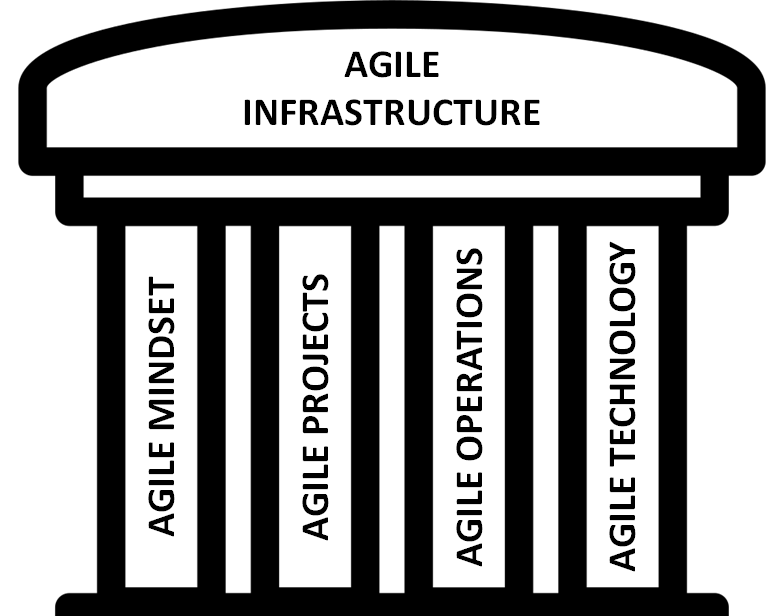It’s been a full two decades since the Agile Manifesto was first published and took the software development world by storm. It prioritized individual actions over processes and tools, and customer satisfaction over strategies and contracts. This enabled companies to ship products earlier while including changes to the scope even late in the development process. These are the building blocks of agile infrastructure.
Such has been the success of Agile methods that they have moved beyond software into marketing, manufacturing and even business leadership.
Agile infrastructure has its origins in the constant attempts to resolve the disconnect between developers, who shipped code fast with agile methodologies and IT infrastructure admins, who had to deal with system configuration, testing, security, application porting, incident management and helpdesk issues before they could deploy the code in a production environment.
This led to the birth of DevOps – or closer collaboration between developer and IT operations teams in order to tighten feedback loops, enable continuous delivery and deployment, automate more tasks that required manual input, and enhance visibility across all business functions and processes using technology.
When IT operations and software workflows can move back and forth without creating bottlenecks and result in direct wins for customers of a business, it can claim to have a truly agile infrastructure. Building an agile infrastructure typically involves dismantling the traditional IT hierarchy and reconstructing technology models to align with business objectives.
The meteoric ascendancy of artificial intelligence (AI) technology and the rigorous computing demands that come with it, has fundamentally transformed all aspects of IT infrastructure, including how agile IT is being approached in this new age.
According to Nutanix’s 2025 Enterprise Cloud Index, 95% of respondents believe that generative AI is changing their organization’s priorities. As IT systems have recently evolved to become more software-defined operations, the focus now turns to scaling in the age of AI.
“I don't think AI is necessarily pushing the limits within data centers yet, but it's going to very, very soon if data centers don't start to adapt to new technologies,” said Harmail Chatha, senior director of cloud operations at Nutanix.
With generative AI, for example, that might mean using hardware that’s specific to the technology. 60% of organizations have a concrete plan around generative AI specific hardware, Nutanix’s survey found.
Artificial intelligence technology is often fed by an immensity of data, so there’s an ongoing shift to private cloud and on-premises data centers that can better secure proprietary information. New data storage technologies are also emerging to support the surging use of AI, with the ability to improve AI applications by accessing data centers across differing infrastructures.
What is an Agile IT Infrastructure?
Agile IT infrastructure is building a flexible computing environment that can adapt to changing demands and technologies. By reducing complexity and facilitating fast and easy changes, deployment is done cheaper, easier and more efficiently. This is in contrast to more rigid infrastructures which struggle to keep pace with an ever-evolving world.
“It ain’t real unless it’s out there and the customers are using it,” said Jon Kern, one of the 17 engineers who wrote the Agile Manifesto, and now an agile transformation consultant. “For me, there’s one sentence that describes what Agile is: Do everything you can to reduce the gap in time from doing something to getting feedback.”
So what are the characteristics of agile infrastructure?
- Increase business value delivered by each workload
- Facilitate digital transformation and remove resistance to change
- Reduce complexity
- Give every employee the opportunity to be a hero by maximizing their productivity
- Increase automation in every process
- Augment orchestration and provisioning of resources
- Boost robustness and resilience of the infrastructure, minimize downtime
- Enable proactive monitoring and predictive maintenance
There are four facets that need to come together for an organization to build an agile infrastructure – the four “pillars” of the structure, so to speak.

Source: Dipti Parmar
Agile Mindset: Before models or processes can change, people need to change. And no amount of Agile or Six Sigma or Lean training can get people to change from the inside out unless they understand how they can deliver better outcomes for the business as well as customers while being more productive in their daily tasks.
Agile Projects: Project managers must make sure the design and architecture of applications are such that software development and operations come together to enable DevOps best practices in all workloads. This facilitates an agile infrastructure that in turn ensures continuous delivery and continuous integration. The capability of the infrastructure should in no way be limited by project budgets.
Agile Operations: The biggest challenge for IT teams of any size – across industries – is that they focus far too much on firefighting as opposed to getting planned things done or delivering customer-centric outcomes. Smaller cross-functional teams of well-rounded engineers can help break down silos between development and infrastructure by documenting processes, increasing automation, optimizing resource usage and managing risks and incidents better.
Agile Technology: The more automation systems an organization can implement and the more modern platforms and technology solutions it can deploy, the more efficiently and effectively it can manage IT operations. Organizations need to identify key technologies that can not only ensure business continuity but also speed up and scale digital transformation initiatives.
Common Agile Infrastructure Technology Models
There are three significant technology models today that form the mainstay of agile infrastructures within organizations.
Virtualization: Virtualization is a way to streamline data center operations by abstracting underlying hardware and software platforms such as servers, operating systems and storage devices into a single virtual machine accessible to an individual, regardless of the device they use to access it.
This enables organizations to eliminate dependency on a particular hardware or software technology or vendor. Avoiding vendor lock-in is critical in an ever-changing technology landscape. IT teams first found success with server virtualization and eventually figured out how to replicate the technology or methods in related areas with virtual desktop infrastructure (VDI) and data virtualization.
Time for real world examples. Ingredients manufacturer Treatt used a traditional three-tier infrastructure consisting of servers, networking and storage. However, this environment was expensive and needed labor-intensive maintenance, which frequently delayed processes and updates.
They made the move to Nutanix’s natively integrated virtualization solution Acropolis Hypervisor (AHV), and in a single shot, transformed their IT infrastructure. Virtualization gave them the luxury of streamlined systems management via a simple, unified UI. As a result, the IT team is able to focus on innovation and strategic projects and proactively deliver value to the company instead of putting out fires, thanks to a more agile infrastructure.
“Treatt handles flavor, and we knew the sooner we could get back to that, the better it would be for our company. Nutanix created its products with a clear intent of being minimally invasive at every stage,” said Brent Gay, Network Engineer at Treatt. “I love that aspect. It felt like closing my eyes in fear as the doctor prepares a shot, only to realize that the process is already over.”
Hyperconverged Infrastructure (HCI): Hyperconvergence streamlines the deployment, management, and scaling of data center resources by bringing all moving parts of the IT infrastructure – including compute, storage and networking resources – under one umbrella. It is the virtualization of every possible stand-alone component of the infrastructure into a distributed platform that enables enterprises to size their workloads precisely and scale as and when needed.
The features of HCI include:
Reduced complexity: A single point solution to integrate server, storage, networking and virtualization resources, with end-to-end operations management capabilities.
Bicycle gear manufacturer Trek was able to reduce their datacenter footprint by a staggering 75% when they moved from a complex 3-tier infrastructure to HCI.
“Our legacy environment filled four racks, and we’re now down to less than half a rack of equipment with Nutanix,” remarked Dane Sandersen, Global Security & Infrastructure Director at Trek.
Quick deployment: Enterprise-level infrastructure can be configured and be up and running in a few hours.
In the backdrop of changing market conditions for the automotive industry, Mercedes-Benz of Brazil was looking to convert their IT infrastructure across four plants into a strategic enabler of innovation rather than simply a cost center. Within days of deploying market-leading hyperconverged systems from Nutanix, they were completing installations at rates 5x higher than their legacy infrastructure. VM installation times were reduced by 75% and server reboots averaged a lightning 3 seconds.
“We experienced speed and simplicity right away,” said Anibal Ulisses Coral, IT Infrastructure Architect at Mercedes-Benz do Brasil. “We now have a more agile development process to provide updates and new features in our apps quicker – and it’s all invisible to the end-user.”
Cost savings: HCI uses commodity hardware just as accessible to SMEs as it is to enterprises and enables capacity expansion in small increments, in step with demand. Software replaces the function of most legacy hardware, leading to further savings in maintenance and upgrade costs.
San Francisco’s Bay Area Rapid Transport implemented a $40 million business transformation project that included a new private cloud for all its applications. While BART saw its management times cut to half and power requirements reduced to a third, the cost savings in capital and operational expenditure were what stood out like neon signs.
“We obtained a 30% reduction in CAPEX by moving from the 3-tier environment to Nutanix,” reported Ravi Misra, CIO of BART. “But the savings are much more than just our technology acquisition costs. We were able to cut the number of IT specialists needed to manage the environment in half.”
For companies that are facing bottlenecks in operational efficiency due to legacy hardware and software architectures, upgrading to HCI is the quickest pathway to Agile.
Hybrid Multicloud: No business – small or large – is a stranger to the power of cloud computing today. The Nutanix Cloud Usage Report 2024 found that hybrid multicloud use is expected to grow over the next few years with 35% of planned deployment models being hybrid multicloud.
The reasons behind the unceasing migration of IT infrastructures to public cloud environments and maturity thereupon to hybrid cloud models are numerous: cost benefits, freedom from vendor lock-in, better security, scalable storage with high-speed access, and overall workload suitability.
What more does an agile infrastructure need? Agile is synonymous with simple. Cloud computing simplifies the IT infrastructure by reducing the amount of hardware and software assets and boosting service automation to improve workload efficiency.
Ward & Uptigrove, one of Ontario’s largest tax and accounting firms, consolidated its IT infrastructure by migrating its VDI, server, and storage systems to the Nutanix Enterprise Cloud. The resulting unified “single pane of glass” management of different components of the infrastructure, accelerated storage performance, and reduced deployment times bettered the user experience for IT admins and departmental employees alike.
“Instead of looking at four or five management consoles, for our SAN, switches, VMware, and other components, we can focus on Nutanix,” said Randy Anderson, IT Manager at Ward & Uptigrove. “In the past, we would have to check compatibility between multiple elements, and carefully schedule upgrades. Now all that complexity is gone.”
“There are frequent updates of our tax and accounting software, so we are always a bit cautious about updating a production image and rolling it out to more than 100 users,” Anderson went on. “Our new solution lets us quickly deploy an image and test it with a few users before we push it out, so we can minimize risk,” he added.
“Nutanix helps us ensure that we deliver the application performance that our employees desire. Our team is spending much less time maintaining and monitoring the hypervisor and hardware, freeing us to do research and testing for more strategic initiatives,” remarked Pat Downey, CEO of Ward & Uptigrove.
4 Steps to a Truly Agile IT Infrastructure
To fully utilize Agile methodologies for improving the IT infrastructure, network teams must change their attitude towards service delivery – they must be comfortable with radical change and a trial-by-error approach. This warrants continuous internal transformation of the IT function itself, with the following steps:
1. A shared vision for IT operations: This involves detailing the infrastructure services that the organizations can provide to its application developers and business users, so that IT teams have a clear idea of the scope and ownership of their tasks. Defining collaboration best practices between the coding and operations teams allows the organization to push through automation solutions faster as well as adapt to new and evolving technologies.
2. Prioritized opportunities: IT leaders need to set clear guidelines and tracking systems for performance improvement and business value creation, so that these can be attributed to improvements in the IT infrastructure. A data-driven understanding of resource consumption in the past and present, and development of algorithms to predict future needs will give the organization a better idea of its infrastructure needs.
3. Focused, agile IT teams: All IT teams need to know the ins and outs of DevOps as well as be comfortable with Agile methodologies such as Scrum and Kanban, so that they can figure out how to use these strategies to build a better IT infrastructure.
4. Sustained transformation: It is the IT leaders’ responsibility to refresh the objectives and priorities of all teams after every digital transformation milestone is passed. More often than not, new opportunities to improve the infrastructure model come to light as soon as current project goals are met.
"We dogfood the products that we actually build," said Nkposong. "So, internally, Agile has been a continuous journey. We use a product and give feedback on it to the product group so they can improve it."
Agile is Not a Replacement for Leadership
For any organization, agile is a way of life. And as with any way of life, it is driven more by people than by processes. The trust and cooperation needed for technical excellence and simplicity can only be achieved with a radical change in the present day top-down attitudes towards value delivery.
“The way the CIO role is defined, conceived and executed today is incompatible with Agile thinking,” wrote Mark Schwartz in his book A Seat at the Table. Today, technology is the first interaction a customer has with the organization. As a result, CIOs need to become more product-centric, user-centric, customer-centric, and data-centric, all at once.
IT operations – or even digital transformation – is not a separate function anymore. Leaders are responsible for constantly reinventing the business according to changing market conditions and customer expectations.
While artificial intelligence and the rigorous data demands that come with it, might rule the day in the present moment, who knows what the next revolutionizing trend might be.
Schwartz pointed out the way forward: “If we re-conceive the role of IT leadership based on Agile principles, we can turn IT into a value creation engine.”
Editor’s note: This is an updated version of the article original published June 6, 2022. Chase Guttman updated this story.
Dipti Parmar is a marketing consultant and contributing writer to Nutanix. She writes columns on major tech and business publications such as IDG’s CIO.com, Adobe’s CMO.com, Entrepreneur Mag, and Inc. Follow her on Twitter @dipTparmar and connect with her on LinkedIn.
© 2025 Nutanix, Inc. All rights reserved. For additional information and important legal disclaimers, please go here.











